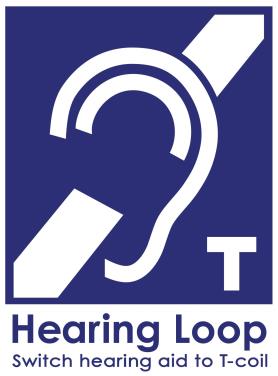The Need to Make A Sound Investment
The Americans with Disabilities Act and other efforts have made the world accessible to all people. However, in some ways that access is incomplete. For millions of Americans using hearing assistive devices, the ability to hear in public facilities is limited. Yet sounds can be made clear by installing a simple and cost effective technology in public buildings and facilities – the induction loop.
What is looping?
The induction loop is to hearing aids, what Wi-Fi is to laptops. Looping allows hearing assistive devices to serve as wireless loudspeakers, delivering clear, sharp, customized sound right from inside the ears. It can be adapted to use in large public spaces, such as airports and auditoriums. But it can just as easily be installed in churches, drive-up business windows and even into a single room at home so the TV or stereo sound becomes a broadcast going directly through the hearing assistive device.
Looping is a cost effective way to make more precise hearing available. The value of also having an area looped in the case of emergency situations is priceless.
Supporting Videos:
How does looping work?
Looping uses two separate technologies: the induction loop and its related components, and the hearing assistive device that has a tele or t-coil.
Induction Loop Systems
The induction loop is usually a high quality single strand copper wire and an amplifier. The size of the space to be looped determines the size and length of the wire loop, as well as the power level of the amplifier.
The public address system, TV or other broadcast source is attached to the looping system amplifier. The looping system amplifier sends the broadcast signal through the looping wire creating a magnetic energy field that can be picked up by tele or t-coils.
Tele-Coils and Hearing Assistive Devices
Also referred to as a “t-switch” or “t-coil”, these are tiny coils of wire that when in the presence of a changing magnetic field – such as those created by an induction loop, create a small electric current, which is transmitted as sound directly to the listener through the speaker in the hearing assistive device. This system bypasses the microphone and amplification function of the device, allowing listeners to hear a broadcast media without hearing the background noise and other competing sounds.
How to Get Involved
There are three ways you can make A Sound Investment:
1. Help get the word out about looping’s value and benefits
One of the best ways is to form a speakers group that gives presentations to churches, synagogues, service clubs and business groups.
HCOA has prepared a presentation specifically for volunteers for other community members. If after these presentations or in response to a PSA effort, additional technical information or support about looping is required, it is available through HCOA and other participating organizations. You could also consider working with the local media to develop public service announcements.
2. Adopt a looping project
There have already been dozens of successful citizen led efforts to loop facilities. Raise funds to loop a local facility that otherwise would not be. Public facilities, like airports, could combine fundraising from direct support and community advocacy. Raise funds to loop a low-income individual’s home with a home-based system.
HCOA can connect you to others who have already met the challenge. Tools and resources to support a looping project are available to HCOA’s Friend Chapters.
3. Support existing looping efforts
Building awareness not enough? Adopting a project too much? Assisting with other’s projects could be the answer. HCOA maintains a list of projects and organizations working in communities across the country. Check out the list of looping vendors or visit the hearing loop website.
The benefits of being involved
The primary benefit is you can become a leader on an important community issue. If you adopt a project or assist with another organization’s project, you will build new volunteer relationships. There is great value in building relationships with other organizations and groups, such as the local American League of Hard of Hearing or the audiology and medical communities.

